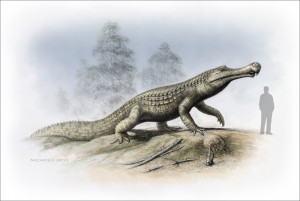New research on crocodiles shows that a combination of changing sea levels and temperatures were responsible for driving their biodiversity over millions of years.
Living crocodiles are threatened by climate change, with 10 out of 23 species at a high risk of extinction. As ectotherms, animals which require external sources of heat to function, they are sensitive to changes in temperature. With 2-4 degrees of increasing global temperatures predicted over the next century, these ruling reptiles have never been more threatened.
The fossil record is our gateway into understanding the evolutionary history of crocodiles. They actually have a long and complex ancestry, going back around 250 million years. During this time, crocodiles and their ancestors, known collectively as crocodyliforms, diversified into an array of forms, including 12-15 foot giants, dwarfed species no bigger than a cat. Some groups even took to the seas, evolving sleek and ‘dolphin-like’ forms, including flippers! The origin of modern crocodiles, known as crocodylians, was around 80 million years ago, during the Cretaceous period. During this time, most of the Earth was experiencing high temperatures, and known as a ‘greenhouse world’.
New research from a team of scientists from the UK and the USA analysed the entire evolutionary history of crocodyliforms, and compared this to data about the history of Earth’s ever changing climate. This included thousands of individual fossil occurrences, documented in the Paleobiology Database, an archive for the history of life.
The team were able to show that at higher latitudes, including regions we now know as Europe and North America, declining temperatures had a major impact on crocodyliform biodiversity. However, at lower latitudes, the fossil record tells a different story. It seems that instead increasing continental aridity, in places like Africa and South America, led to declines in crocodyliforms. Over the last 50 million years, this has led to the long term decline of crocodylians from temperate environments, and seems to have been caused the descent into the modern day ‘icehouse world’.
For example, Africa 10 million years ago was a very different place to how we now know it. The Sahara Desert was just forming, and replaced the lush wetlands in which crocodiles thrived. In South America, as the Andes Mountains rose more recently, the wetland habitats in the proto-Amazon were forever altered, making life extremely uncomfortable for the local crocodiles.
At the end of the Cretaceous, 66 million years ago, there was a mass extinction event, one notoriously known for its decimation of all the dinosaurs (apart from birds). While almost no group around at this time went unscathed, it seems that crocodyliforms were actually able to take advantage of extinctions, including those of all other predaceous marine reptiles, and radiate into new habitats and ecologies that were now vacant.
Going back further in time to the Jurassic and the Cretaceous, freely swimming crocodiles inhabited the oceans alongside a range of bizarre marine reptiles. Instead of temperature and climate shaping their evolution, it seems like changing sea-levels were most responsible for their fate. Sea level is known to control the evolution of near-shore habitats, including reef systems, by changing how habitable the continental shelf regions are. As sea levels rise, these habitats become more diverse by increasing the amount of area available to live, but as sea-levels fall, these habitats can be destroyed entirely.
On land, crocodyliforms diversified into groups completely alien to how we know their living descendants. One group, called Notosuchia, looked like the bizarre offspring of a crocodile and an armadillo, and more resembled a walking tank. During the Late Cretaceous, these notosuchians reached the highest levels of diversity than any other crocodyliform group throughout their history, in the tropics of then South America.
Dr. Phillip Mannion, co-lead author from Imperial College London (and my PhD supervisor!), said: “While they [crocodylians] have a fearsome reputation, these creatures are vulnerable and looking back in time we’ve been able to determine what environmental factors had the greatest impact on them. This may help us to determine how they will cope with future changes.” The research is published in the journal Nature Communications, and is open access so free for anyone to read and re-use!
What we might see in the future, with increasing global temperatures, is the expansion of crocodylians outside of the tropics. Along with this, they might actually increase in biodiversity, but the impact of human activities on this through habitat destruction might act to counter this.
The next step for researchers is to look at similar patterns in other groups with long evolutionary histories, including birds and mammals, and see how climate change helped to shape modern ecosystems.
Note: the author of this article is a co-author on the study.


Pingback: Morsels For The Mind – 25/09/2015 › Six Incredible Things Before Breakfast